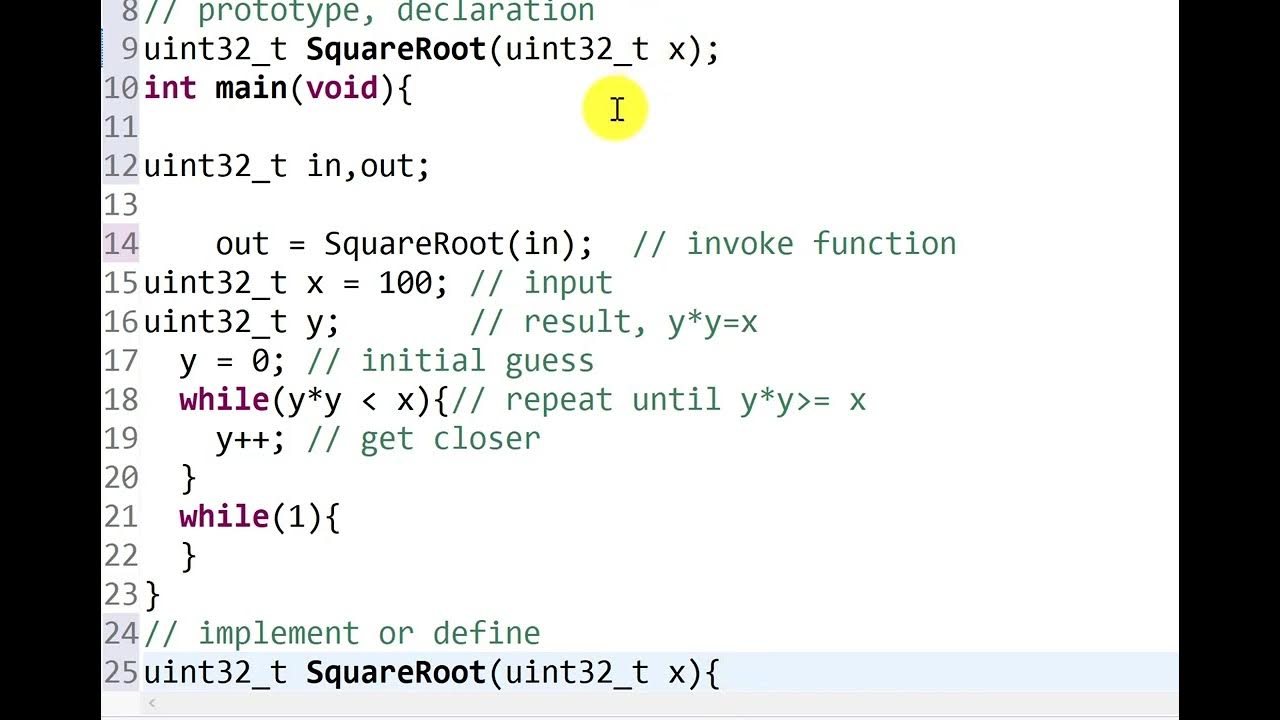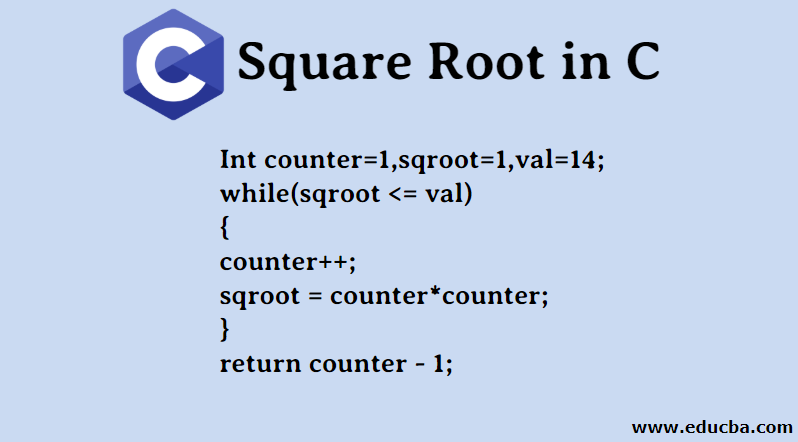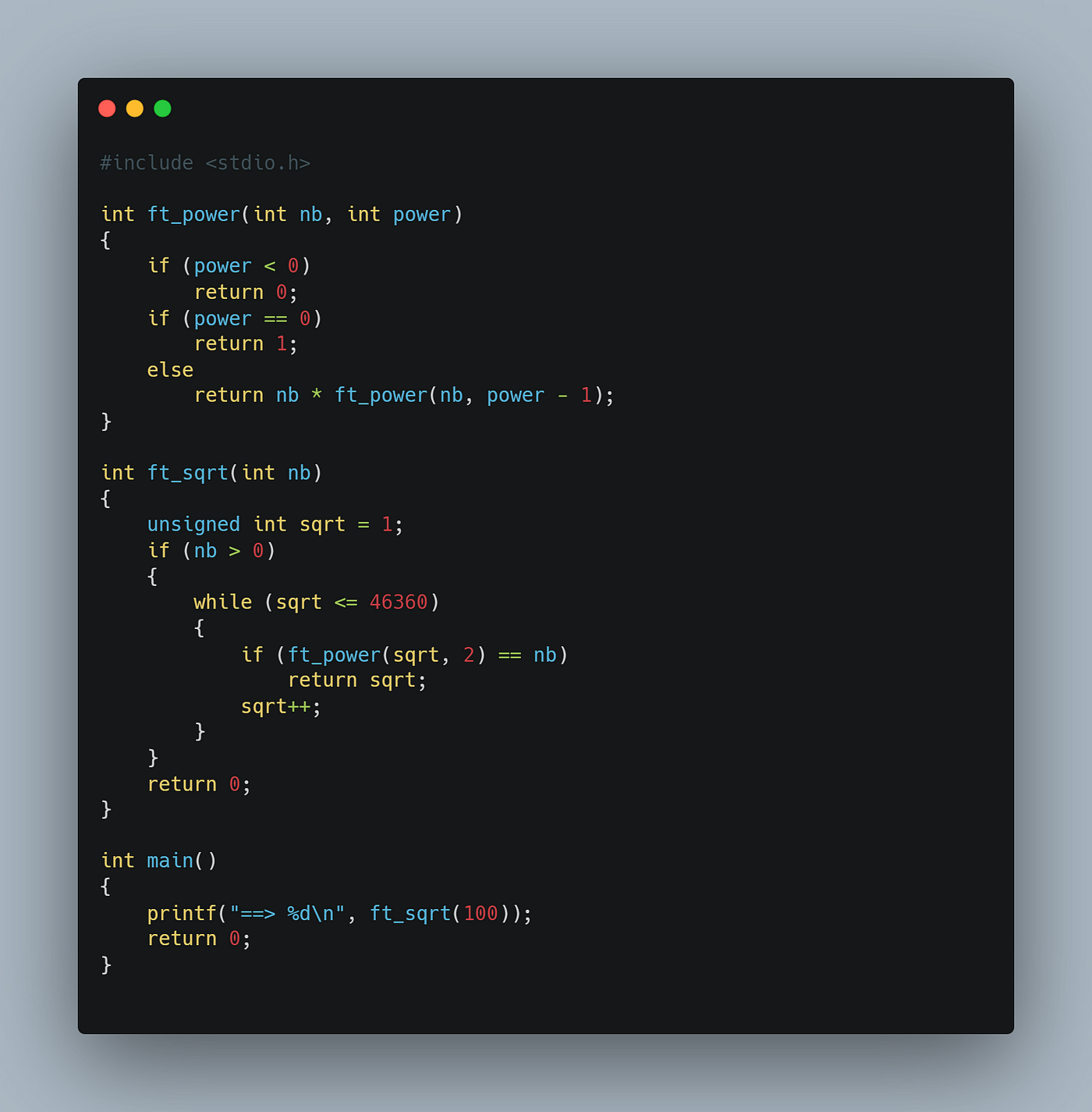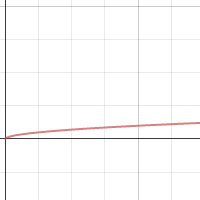Topic c square root function: The C square root function, sqrt(), is a crucial part of the C standard library, enabling developers to calculate the square root of numbers efficiently. This article explores the syntax, usage, and practical examples of the sqrt() function, helping both beginners and experienced programmers to harness its full potential in their C programming projects.
Table of Content
C sqrt() Function
The sqrt() function in C is part of the math.h library and is used to calculate the square root of a number.
Function Prototype
The function prototype for sqrt() is:
double sqrt(double x);Parameters
x: The number for which the square root is to be calculated. This parameter is of typedouble.
Return Value
The sqrt() function returns the square root of the given number as a double. If the input is negative, the function returns NaN (Not a Number).
Example Usage
Here is an example of using the sqrt() function:
#include
#include
int main() {
double number = 25.0;
double result = sqrt(number);
printf("Square root of %.2f is %.2f\n", number, result);
return 0;
}
Output:
Square root of 25.00 is 5.00
Additional Examples
#include
#include
int main() {
printf("Square root of %lf is %lf\n", 4.0, sqrt(4.0));
printf("Square root of %lf is %lf\n", 5.0, sqrt(5.0));
return 0;
}
Output:
Square root of 4.000000 is 2.000000 Square root of 5.000000 is 2.236068
Handling Different Data Types
To find the square root of different data types, you can use type casting. For instance:
int x = 0;
double result;
result = sqrt((double)x);For floats and long doubles, you can use sqrtf() and sqrtl() respectively:
long double sqrtl(long double arg);
float sqrtf(float arg);Common Use Cases
- Calculating the side length of a square given its area.
- Geometric calculations.
- Physics calculations involving square roots.
Optimization
The sqrt() function is optimized for performance and generally does not require additional optimization. However, if performance is critical, profiling your code to identify bottlenecks can be helpful.
Conclusion
The sqrt() function is a valuable tool in C for performing square root calculations efficiently. It is widely used in various mathematical and scientific applications.

Introduction to C sqrt() Function
The sqrt() function in C is a standard library function defined in the math.h header file. It is used to calculate the square root of a given number. The function takes a single argument of type double and returns the square root of the provided value, also as a double. This function is essential for performing mathematical computations involving square roots in C programming.
Here's the prototype for the sqrt() function:
double sqrt(double x);
In the prototype, x is the floating-point value for which you want to find the square root.
The sqrt() function is versatile and can handle various data types by casting them to double. For instance, if you have an integer value, you can cast it to double before passing it to the sqrt() function:
int num = 16;
double result = sqrt((double)num);
This will correctly compute the square root of 16, which is 4.0.
Here is a simple example demonstrating the usage of the sqrt() function:
#include
#include
int main() {
double number, result;
printf("Enter a number: ");
scanf("%lf", &number);
result = sqrt(number);
printf("Square root of %.2lf is %.2lf\n", number, result);
return 0;
}
When you run this program, it prompts the user to enter a number, computes the square root of the entered number, and displays the result.
For special cases, such as finding the square root of a negative number, the sqrt() function will return NaN (Not a Number) since the square root of a negative number is not defined in the real number system.
Additionally, the sqrt() function has variants like sqrtf() and sqrtl() for working with float and long double types, respectively:
float sqrtf(float x);
long double sqrtl(long double x);
These variants ensure that you can handle different precision requirements efficiently.
Syntax and Usage
The sqrt() function in C is a built-in function used to calculate the square root of a given number. It is part of the math.h library and has the following syntax:
double sqrt(double x);
Here, x is the parameter, which is a non-negative floating-point number whose square root is to be computed. The function returns a double representing the square root of x.
Usage Example
The following example demonstrates the usage of the sqrt() function:
#include
#include
int main() {
double number = 25.0;
double result;
result = sqrt(number);
printf("The square root of %.2f is %.2f\n", number, result);
return 0;
}
Output:
The square root of 25.00 is 5.00
Handling Invalid Input
If a negative number is passed to the sqrt() function, it returns NaN (Not a Number). Here's an example that demonstrates this:
#include
#include
int main() {
double number = -25.0;
double result;
result = sqrt(number);
if (isnan(result)) {
printf("The input is invalid (negative number).\n");
} else {
printf("The square root of %.2f is %.2f\n", number, result);
}
return 0;
}
Output:
The input is invalid (negative number).
Common Use Cases
- Calculating the distance between two points in a plane using the distance formula.
- Solving quadratic equations where finding the square root of the discriminant is necessary.
- Engineering and physics calculations that require square root operations.
Examples
Below are some examples of how to use the sqrt() function in C to calculate the square root of various numbers:
Example 1: Basic Usage
This example demonstrates the basic usage of the sqrt() function to find the square root of a positive number.
#include
#include
int main() {
double number = 16.0;
double result;
result = sqrt(number);
printf("The square root of %.2f is %.2f\n", number, result);
return 0;
} Output: The square root of 16.00 is 4.00
Example 2: Square Root of Zero
This example shows how the sqrt() function handles zero.
#include
#include
int main() {
double number = 0.0;
double result;
result = sqrt(number);
printf("The square root of %.2f is %.2f\n", number, result);
return 0;
} Output: The square root of 0.00 is 0.00
Example 3: Square Root of a Negative Number
Attempting to calculate the square root of a negative number results in an error. This example demonstrates how to handle such cases using error checking.
#include
#include
#include
int main() {
double number = -4.0;
double result;
errno = 0; // Reset errno before function call
result = sqrt(number);
if (errno == EDOM) {
printf("Error: Attempted to calculate the square root of a negative number.\n");
} else {
printf("The square root of %.2f is %.2f\n", number, result);
}
return 0;
} Output: Error: Attempted to calculate the square root of a negative number.
Example 4: Using Variables
This example demonstrates the usage of variables to store the input number and the result of the square root calculation.
#include
#include
int main() {
double number;
double result;
printf("Enter a number: ");
scanf("%lf", &number);
result = sqrt(number);
printf("The square root of %.2f is %.2f\n", number, result);
return 0;
} Output: The square root of
Return Values
The sqrt() function in C is used to compute the square root of a given number. It returns the square root of the argument passed to it. The return value can be categorized based on the type and value of the input:
- Positive Number: If the input is a positive number, the
sqrt()function returns the positive square root of the number. For example,sqrt(16.0)returns4.0. - Zero: If the input is zero, the function returns zero. For example,
sqrt(0.0)returns0.0. - Negative Number: If the input is a negative number, the behavior of the
sqrt()function is undefined in standard C. It may return a domain error or produce a Not-a-Number (NaN) result depending on the implementation. For instance,sqrt(-1.0)might return NaN.
Here is a summary table of possible return values:
| Input | Return Value | Description |
|---|---|---|
| Positive Number | Positive Square Root | Returns the positive square root of the number. |
| Zero | Zero | Returns zero. |
| Negative Number | NaN or Domain Error | May return NaN or produce a domain error, depending on the implementation. |
It's important to handle return values correctly to ensure the robustness of your program, especially when dealing with potential domain errors or unexpected inputs.

Optimizations and Performance
The sqrt() function in C is generally optimized for accuracy and efficiency. However, there are several techniques and considerations to enhance its performance further:
- Hardware Support: Many modern processors include dedicated hardware instructions for computing square roots, which can significantly speed up the operation. For instance, using assembly code to leverage the processor’s built-in square root functions can yield performance benefits.
- Compiler Optimizations: Compilers like GCC and Clang have optimization flags (e.g.,
-O2,-O3) that can improve the performance of mathematical functions, includingsqrt(), by inlining and using efficient instruction sets. - Approximation Algorithms: For scenarios where approximate results are acceptable, using algorithms such as the Newton-Raphson method or lookup tables can provide faster computations at the expense of some precision. These methods iteratively refine an initial guess to quickly converge to the square root value.
- Algorithmic Improvements: For large-scale computations, especially with big integers, customized algorithms can be implemented. For example, using bit manipulation techniques or specialized libraries for arbitrary-precision arithmetic can handle very large numbers more efficiently.
Here is an example using the Newton-Raphson method to approximate the square root:
#include
double sqrt_newton(double x) {
double guess = x / 2.0;
double epsilon = 0.00001;
while ((guess * guess - x) > epsilon || (x - guess * guess) > epsilon) {
guess = (guess + x / guess) / 2.0;
}
return guess;
}
int main() {
double num = 25.0;
printf("The square root of %.2f is approximately %.5f\n", num, sqrt_newton(num));
return 0;
}
By implementing these optimization techniques, the performance of square root calculations can be improved, making them suitable for high-performance and real-time applications.
Error Handling
When using the sqrt() function in C, proper error handling is crucial to ensure the robustness of your program. The sqrt() function can encounter different types of errors, primarily domain errors. Here is a detailed explanation of how to handle these errors effectively:
- Domain Error: This occurs if the argument passed to the
sqrt()function is negative. Since the square root of a negative number is not defined in the set of real numbers, the function will return a domain error. - Checking for Domain Errors: To handle domain errors, you can use the
errnovariable or check the returned value forNaN(Not a Number). Themath.hheader defines the constantEDOMto indicate a domain error.
Here is an example demonstrating how to handle errors using errno:
#include
#include
#include
int main(void) {
double x, y;
errno = 0;
x = -25.0;
y = sqrt(x);
if (errno == EDOM) {
perror("Error");
} else {
printf("The square root of %f is %f\n", x, y);
}
return 0;
}
In this example:
- We include the necessary headers:
math.hfor thesqrt()function anderrno.hfor error handling. - We initialize
errnoto 0 before calling thesqrt()function. - We call the
sqrt()function with a negative value, which will seterrnotoEDOM. - We check if
errnois set toEDOMand print an error message usingperror().
IEEE Floating-Point Arithmetic: If the implementation supports IEEE floating-point arithmetic (IEC 60559), additional rules apply:
- If the argument is less than -0,
FE_INVALIDis raised andNaNis returned. - If the argument is +∞ or ±0, it is returned unmodified.
- If the argument is
NaN,NaNis returned.
By incorporating proper error handling in your use of the sqrt() function, you can ensure that your programs handle edge cases and erroneous inputs gracefully.
Advanced Usage
The sqrt() function in C provides a straightforward method to compute the square root of a number. However, advanced usage involves leveraging it in complex mathematical and scientific computations. Below are some advanced applications:
1. Using sqrt() with Complex Numbers
To handle complex numbers, the C library provides the csqrt() function, which computes the square root of a complex number. Here’s an example:
#include
#include
#include
int main() {
double complex z = 4.0 + 9.0*I;
double complex result = csqrt(z);
printf("The square root of %.2f + %.2fi is %.2f + %.2fi\n", creal(z), cimag(z), creal(result), cimag(result));
return 0;
}
2. Optimizing Performance
For performance-critical applications, consider the following optimizations:
- Minimize calls to
sqrt()by storing results when possible. - Use compiler optimizations and hardware-specific instructions.
3. Computing Square Roots in Bulk
When dealing with large datasets, vectorization can improve performance. The following example uses the Intel Math Kernel Library (MKL) to compute square roots of an array of numbers:
#include
#include
int main() {
int n = 1000;
double x[1000], y[1000];
// Initialize array x with values
for (int i = 0; i < n; i++) {
x[i] = (double)i;
}
// Compute square roots
vdSqrt(n, x, y);
// Print the first 10 results
for (int i = 0; i < 10; i++) {
printf("sqrt(%.2f) = %.2f\n", x[i], y[i]);
}
return 0;
}
4. Error Handling and Edge Cases
Proper error handling is crucial, especially for edge cases:
- Ensure the input is non-negative when using
sqrt()with real numbers. - Check for potential overflow or underflow in computations.
#include
#include
#include
int main() {
errno = 0;
double result = sqrt(-1.0);
if (errno == EDOM) {
perror("Error computing sqrt");
} else {
printf("The square root is %.2f\n", result);
}
return 0;
}
5. Combining sqrt() with Other Functions
For complex mathematical operations, combining sqrt() with other functions can be powerful:
#include
#include
int main() {
double x = 16.0;
double y = 2.0;
double result = sqrt(pow(x, y));
printf("The result of sqrt(pow(%.2f, %.2f)) is %.2f\n", x, y, result);
return 0;
}
By leveraging these advanced techniques, you can effectively utilize the sqrt() function in a variety of complex and performance-critical applications.
Related Functions
In the C programming language, several mathematical functions are related to the sqrt() function, which is used to calculate the square root of a number. These functions are part of the math.h library and are useful for various mathematical computations.
- pow(): This function raises a number to a specified power. Its prototype is
double pow(double base, double exponent);For example,pow(2.0, 3.0)returns 8.0. - exp(): This function calculates the exponential of a number (e raised to the power of the given number). Its prototype is
double exp(double x);For example,exp(1.0)returns approximately 2.71828. - log(): This function returns the natural logarithm (base e) of a number. Its prototype is
double log(double x);For example,log(2.71828)returns 1.0. - log10(): This function calculates the base-10 logarithm of a number. Its prototype is
double log10(double x);For example,log10(100.0)returns 2.0. - fabs(): This function returns the absolute value of a floating-point number. Its prototype is
double fabs(double x);For example,fabs(-3.14)returns 3.14. - hypot(): This function calculates the hypotenuse of a right-angled triangle given the lengths of the other two sides. Its prototype is
double hypot(double x, double y);For example,hypot(3.0, 4.0)returns 5.0. - sqrtf(): This is a variation of the
sqrt()function that operates onfloatvalues. Its prototype isfloat sqrtf(float x); - sqrtl(): This is another variation of the
sqrt()function that operates onlong doublevalues. Its prototype islong double sqrtl(long double x);
These functions provide a wide range of capabilities for mathematical operations in C, complementing the use of the sqrt() function for different types of computations.

Hướng dẫn lập trình C: Học cách sử dụng hàm tính căn bậc hai trong C để giải quyết các bài toán toán học nhanh chóng và hiệu quả.
Hướng Dẫn Lập Trình C - Hàm Tính Căn Bậc Hai
READ MORE:
Hướng dẫn cách tìm căn bậc hai sử dụng hàm sqrt(), sqrtf(), sqrtl() trong lập trình C. Video này giúp bạn hiểu rõ hơn về cách dùng các hàm tính căn bậc hai trong ngôn ngữ C.
Tìm Căn Bậc Hai Sử Dụng sqrt() sqrtf() sqrtl() | Hướng Dẫn Lập Trình C

















